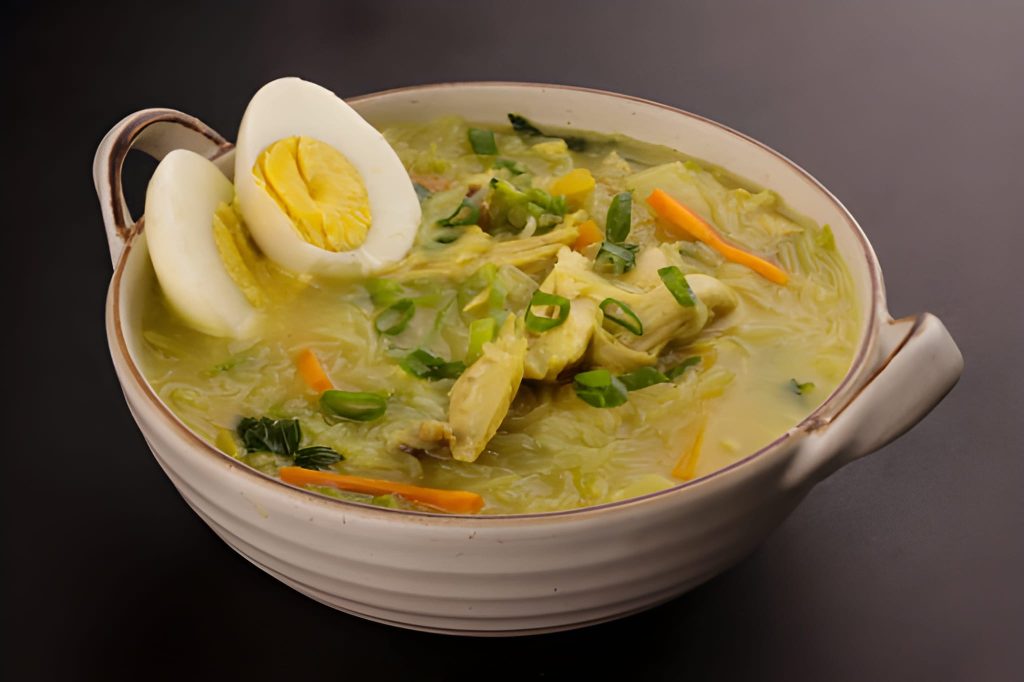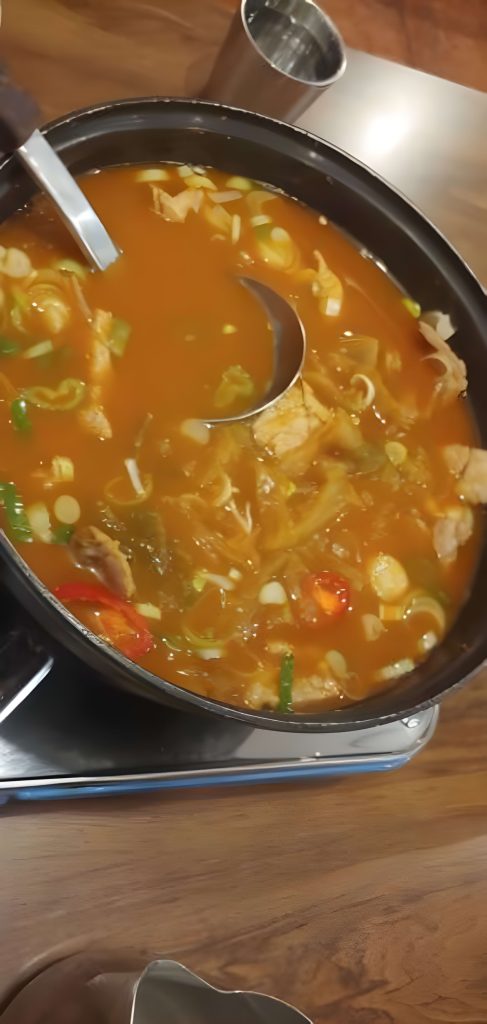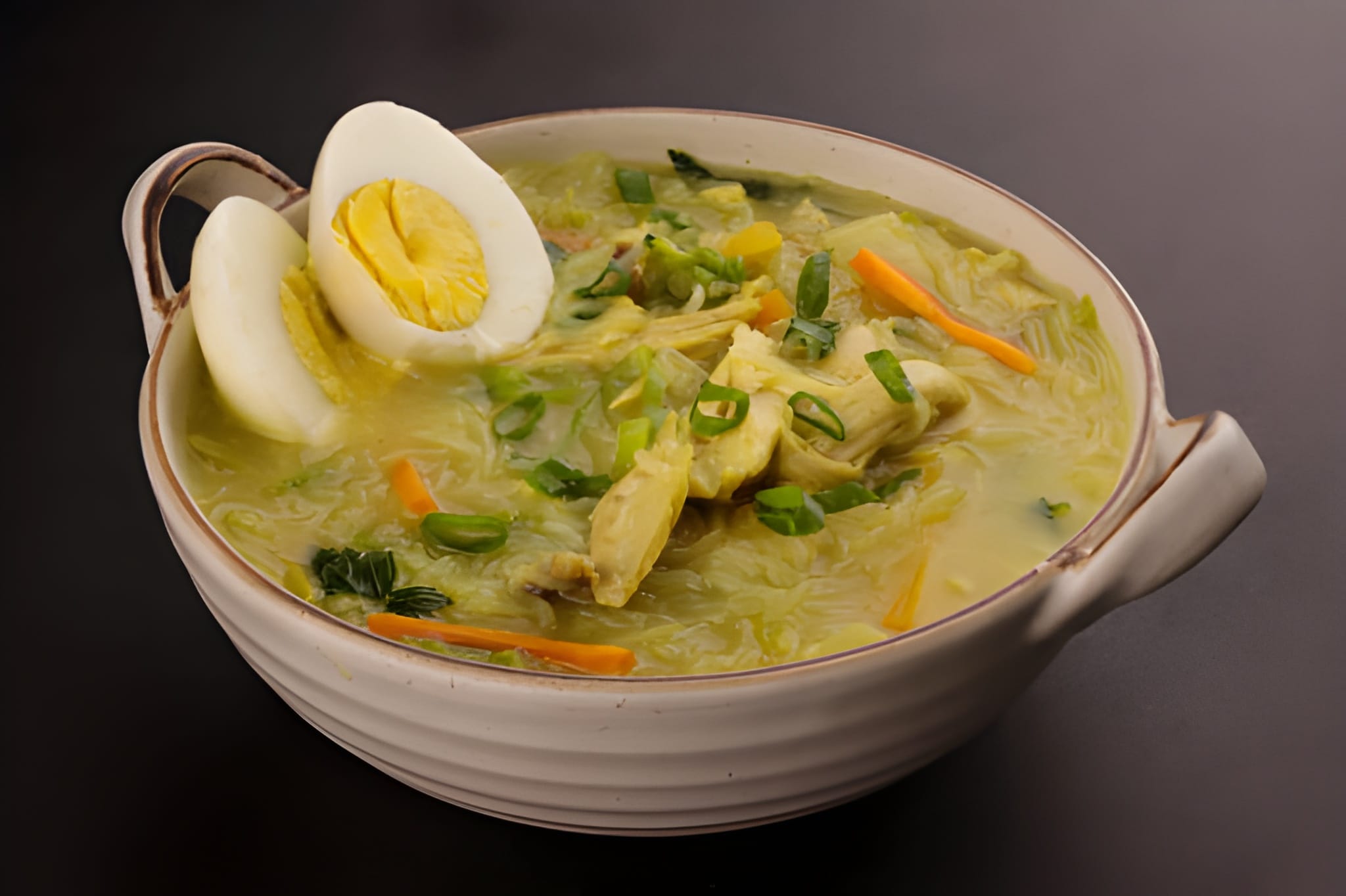Chicken Sotanghon Recipe
A warm and flavorful Filipino noodle soup featuring tender chicken wings, glass noodles, and aromatic vegetables simmered in a rich, golden broth. Comforting, hearty, and perfect for cool days or family gatherings, this dish brings together homestyle flavors and soothing warmth in every spoonful.

Ingredient Breakdown
The soul of this dish lies in its rich, savory foundation — simmered chicken wings that slowly release their natural juices to create a deeply flavored broth. The fat from the wings enriches the soup without overpowering it, lending a luxurious mouthfeel that defines Chicken Sotanghon’s comforting appeal. The chicken broth reinforces this richness, forming the perfect canvas for the layers of flavor that follow.
The trio of aromatics — ginger, garlic, and onion — builds the broth’s fragrant base. As they sauté in oil, their aromas bloom, infusing the kitchen with warmth. Fish sauce adds depth and umami, enhancing the savory profile and giving the dish that signature Filipino character. Annatto powder plays a dual role: it imparts an earthy undertone while tinting the soup a beautiful golden-orange hue.
Fresh vegetables add vibrancy and balance. Julienne-cut carrots offer sweetness and crunch, napa cabbage provides a tender bite, and chopped Chinese celery (kinchay) contributes a subtle herbal note that brightens the dish. The sotanghon noodles — delicate glass noodles made from mung bean starch — absorb the rich broth beautifully, ensuring that each bite carries the full depth of flavor. The final touches of boiled eggs, fried garlic bits, and green onions make every serving as aromatic as it is satisfying.
Step-by-Step Preparation Guide
The dish begins with building an aromatic foundation. Heating canola oil in a large pot, the onion, garlic, and ginger are sautéed until golden and fragrant. Their aromas awaken the senses, forming the base that supports the rest of the ingredients. Chicken wings are then added, searing lightly until browned and glistening. This process locks in flavor, ensuring that each piece infuses the broth with richness as it simmers.
Once the chicken is partially cooked, Chinese celery joins the mix, lending freshness and a faint peppery aroma. A splash of fish sauce follows, deepening the savory essence before the chicken broth is poured in. As the liquid reaches a gentle boil, impurities rise to the surface and are skimmed off, resulting in a clear, pristine broth. The pot is then covered, allowing the chicken to cook slowly until tender and juicy.
To give the soup its signature hue, a portion of the hot broth is mixed with annatto powder, then poured back into the pot, transforming the broth into a glowing golden color. Julienne carrots are stirred in next, softening slightly while maintaining their vibrant color and crunch.
The sotanghon noodles are added at this stage, absorbing the flavorful liquid as they soften. A gentle stir ensures even cooking and prevents clumping. Finally, shredded napa cabbage is folded in, cooking briefly until tender yet still crisp. The result is a harmonious blend of textures and aromas — light, savory, and deeply comforting. Each bowl is then assembled with halved boiled eggs, a generous sprinkle of fried garlic bits, and a handful of fresh green onions for a burst of color and fragrance.

Recipe Tips & Frequently Asked Questions
Keep the broth clear by skimming off impurities that rise to the surface as the chicken simmers. A gentle simmer, not a rolling boil, prevents cloudiness.
Soak the sotanghon noodles in warm water before adding them to the soup. This keeps their texture pleasantly chewy and prevents them from absorbing too much broth.
Adjust the amount of annatto powder to control the soup’s color — a little for a light golden tint, or more for a deeper, earthy tone.
When frying garlic bits, use low heat and stir often. This ensures they turn evenly golden without burning, preserving their delicate flavor.
To store leftovers, cool the soup completely and refrigerate in an airtight container for up to 2 days. Reheat gently, adding a splash of broth or water to loosen the noodles.
You can substitute sotanghon noodles with bihon or rice vermicelli if desired.
The soup can be prepared ahead for gatherings — just cook the noodles separately and add them before serving.
To prevent noodles from absorbing too much broth, store them apart from the soup and combine just before reheating.
What to Serve With This Recipe
Chicken Sotanghon shines as a standalone meal but pairs wonderfully with simple Filipino sides. Steamed white rice or warm pandesal makes a hearty complement, soaking up the flavorful broth. For a more filling spread, serve it alongside crispy lumpiang shanghai or vegetable spring rolls for contrast in texture.
Light, refreshing drinks enhance the experience — calamansi juice offers a citrusy lift, while warm ginger tea complements the soup’s comforting nature. Coconut water also makes a cooling and naturally sweet pairing. Whether enjoyed for lunch, dinner, or a rainy-day treat, each pairing enhances the cozy, homestyle essence of this dish.
Creative Variations
To make a lighter version, substitute the chicken wings with chicken breast or thighs for less fat but the same flavorful result. For a festive touch, shred cooked chicken and add mushrooms or bamboo shoots for added depth and heartiness. Those who enjoy heat can stir in chili flakes or a drizzle of chili oil, transforming the soup into a mildly spicy delight. You can also customize the toppings — add crispy shallots, toasted sesame oil, or crushed chicharrón for a unique spin.
Chicken Sotanghon captures the essence of Filipino comfort food — a dish that’s both humble and deeply satisfying. The savory broth, infused with ginger, garlic, and annatto, blends seamlessly with tender chicken and translucent noodles. Each bowl feels like a warm embrace, reminding one of home-cooked meals shared with family. Whether served during celebrations or simple cozy dinners, this timeless soup never fails to bring comfort and warmth to the table.

Ingredients
2 pounds chicken wings, tips removed and cut into 2-inch pieces
7 cups chicken broth
1 tablespoon canola oil
1 onion, peeled and thinly sliced
4 cloves garlic, minced
1 thumb-size piece of ginger, peeled and julienned
2 tablespoons fish sauce
2 teaspoons annatto powder
1 cup Chinese celery (kinchay), chopped
2 large carrots, peeled and julienned
½ head napa cabbage, shredded
4 ounces (about 2 coils) sotanghon noodles
Salt and pepper, to taste
3 hard-boiled eggs, halved
Fried garlic bits, for topping
Chopped green onions, for garnish
For the Fried Garlic Bits
½ cup cooking oil
1 head garlic, peeled and minced
Instructions
Heat canola oil in a large pot over medium flame. Add the sliced onion, minced garlic, and julienned ginger, sautéing gently until the mixture becomes aromatic and the onion turns translucent. Add the chicken wings and cook for several minutes, stirring occasionally, until they begin to brown lightly and release their natural juices.
Toss in the chopped Chinese celery and stir for 1 to 2 minutes until it softens slightly. Pour in the fish sauce and continue cooking briefly to enhance the depth of flavor. Add the chicken broth, then bring the mixture to a boil. Skim off any foam or impurities that float to the surface to ensure a clear, clean-tasting soup. Lower the heat, cover the pot, and let the chicken simmer gently until fully cooked and tender.
In a small bowl, combine about ½ cup of the hot broth with the annatto powder. Stir until the powder is fully dissolved, then pour this vibrant orange liquid back into the pot to add both color and a subtle earthiness to the soup.
Add the julienned carrots and cook for 1 to 2 minutes, allowing them to soften but still retain their shape. Season the broth with salt and pepper to your taste. Next, place the sotanghon noodles into the pot, gently pressing them down so they soak in the flavorful broth. Stir lightly to separate the strands as they soften.
When the noodles are nearly tender, add the shredded napa cabbage and continue cooking for 2 to 3 minutes, just until the vegetables are crisp-tender and the noodles fully cooked. The soup should be rich, fragrant, and lightly golden in hue.
To serve, ladle the hot soup into deep bowls. Top each serving with halved boiled eggs, a generous sprinkle of fried garlic bits, and chopped green onions for a fresh, aromatic finish. Serve immediately while piping hot.
For the Fried Garlic Bits
In a small pan, heat the oil over low heat. Add the minced garlic and cook slowly, stirring every few minutes to prevent burning. Allow it to fry gently for about 10 to 15 minutes, until it turns a deep golden brown and fragrant. Using a slotted spoon, transfer the garlic to a plate lined with paper towels to drain excess oil. As it cools, it will turn perfectly crisp — ideal for topping your steaming bowl of Chicken Sotanghon.

Chicken Sotanghon Recipe
Ingredients
- 2 pounds chicken wings tips removed and cut into 2-inch pieces
- 7 cups chicken broth
- 1 tablespoon canola oil
- 1 onion peeled and thinly sliced
- 4 cloves garlic minced
- 1 thumb-size piece of ginger peeled and julienned
- 2 tablespoons fish sauce
- 2 teaspoons annatto powder
- 1 cup Chinese celery kinchay, chopped
- 2 large carrots peeled and julienned
- ½ head napa cabbage shredded
- 4 ounces about 2 coils sotanghon noodles
- Salt and pepper to taste
- 3 hard-boiled eggs halved
- Fried garlic bits for topping
- Chopped green onions for garnish
For the Fried Garlic Bits
- ½ cup cooking oil
- 1 head garlic peeled and minced
Instructions
- Heat canola oil in a large pot over medium flame. Add the sliced onion, minced garlic, and julienned ginger, sautéing gently until the mixture becomes aromatic and the onion turns translucent. Add the chicken wings and cook for several minutes, stirring occasionally, until they begin to brown lightly and release their natural juices.
- Toss in the chopped Chinese celery and stir for 1 to 2 minutes until it softens slightly. Pour in the fish sauce and continue cooking briefly to enhance the depth of flavor. Add the chicken broth, then bring the mixture to a boil. Skim off any foam or impurities that float to the surface to ensure a clear, clean-tasting soup. Lower the heat, cover the pot, and let the chicken simmer gently until fully cooked and tender.
- In a small bowl, combine about ½ cup of the hot broth with the annatto powder. Stir until the powder is fully dissolved, then pour this vibrant orange liquid back into the pot to add both color and a subtle earthiness to the soup.
- Add the julienned carrots and cook for 1 to 2 minutes, allowing them to soften but still retain their shape. Season the broth with salt and pepper to your taste. Next, place the sotanghon noodles into the pot, gently pressing them down so they soak in the flavorful broth. Stir lightly to separate the strands as they soften.
- When the noodles are nearly tender, add the shredded napa cabbage and continue cooking for 2 to 3 minutes, just until the vegetables are crisp-tender and the noodles fully cooked. The soup should be rich, fragrant, and lightly golden in hue.
- To serve, ladle the hot soup into deep bowls. Top each serving with halved boiled eggs, a generous sprinkle of fried garlic bits, and chopped green onions for a fresh, aromatic finish. Serve immediately while piping hot.
For the Fried Garlic Bits
- In a small pan, heat the oil over low heat. Add the minced garlic and cook slowly, stirring every few minutes to prevent burning. Allow it to fry gently for about 10 to 15 minutes, until it turns a deep golden brown and fragrant. Using a slotted spoon, transfer the garlic to a plate lined with paper towels to drain excess oil. As it cools, it will turn perfectly crisp — ideal for topping your steaming bowl of Chicken Sotanghon.

